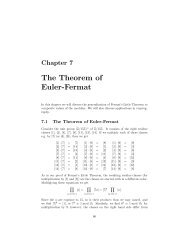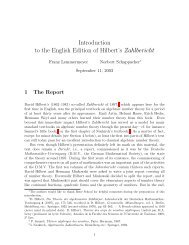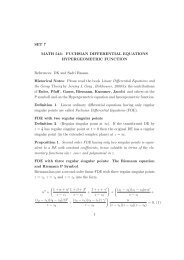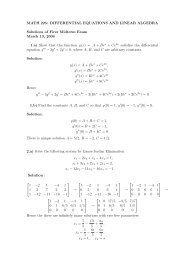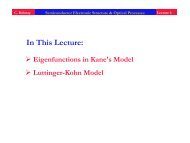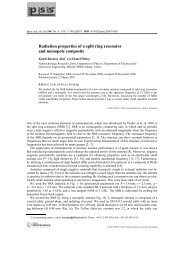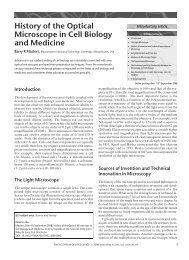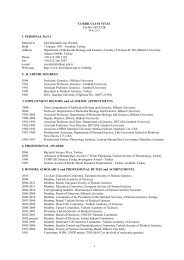How to Find the Absolute Maximum and the Absolute Minimum ...
How to Find the Absolute Maximum and the Absolute Minimum ...
How to Find the Absolute Maximum and the Absolute Minimum ...
You also want an ePaper? Increase the reach of your titles
YUMPU automatically turns print PDFs into web optimized ePapers that Google loves.
Example: <strong>Find</strong> <strong>the</strong> <strong>the</strong> absolute maximum <strong>and</strong> <strong>the</strong> absolute minimum values of f(x, y) =<br />
x 3 − xy + y 2 − x on R = {(x, y) : x ≥ 0, y ≥ 0 <strong>and</strong> x + y ≤ 2}.<br />
We apply <strong>the</strong> algorithm:<br />
1. fx = 3x 2 − y − 1 <strong>and</strong> fy = −x + 2y.<br />
2. We have <strong>to</strong> solve <strong>the</strong> equations 3x 2 − y − 1 = 0 <strong>and</strong> −x + 2y = 0 simultaneously.<br />
From <strong>the</strong> second one we solve for x <strong>to</strong> get x = 2y <strong>and</strong> substitute it in <strong>the</strong> first one<br />
<strong>to</strong> get 3 · (2y) 2 − y − 1 = 0 =⇒ 12y 2 − y − 1 = 0 =⇒ y = 1/3 or y = −1/4 . Since<br />
x = 2y, <strong>the</strong>se give <strong>the</strong> x-values y = 1/3 =⇒ x = 2/3 <strong>and</strong> y = −1/4 =⇒ x = −1/2.<br />
So we obtain <strong>the</strong> points (x, y) = (2/3, 1/3) <strong>and</strong> (x, y) = (−1/2, −1/4). Note that<br />
<strong>the</strong> second point is not in R. So we put only <strong>the</strong> first one, (2/3, 1/3) in our list.<br />
This is important! If you include points that are not in R in your list, <strong>the</strong>re is no<br />
guarantee that <strong>the</strong> algorithm will give <strong>the</strong> correct answer.<br />
3. Now we come <strong>to</strong> <strong>the</strong> boundary. The boundary of R is <strong>the</strong> union of three sides of <strong>the</strong><br />
triangle: Side I = {(x, y) : 0 ≤ x ≤ 2 <strong>and</strong> y = 0}, Side II = {(x, y) : x = 0 <strong>and</strong> 0 ≤<br />
y ≤ 2} <strong>and</strong> Side III = {(x, y) : x + y = 2 <strong>and</strong> 0 ≤ x ≤ 2}. So we have essentially<br />
three 1-variable problems <strong>to</strong> solve:<br />
Side I : We parametrize this side in <strong>the</strong> obvious way: x = t, y = 0 for 0 ≤ t ≤ 2.<br />
Then <strong>the</strong> restrictions of f <strong>to</strong> Side I is f(t, 0) = t 3 · 0 − t · 0 − 0 2 − t = t 3 − t for<br />
0 ≤ t ≤ 2. Now we find <strong>the</strong> list of points for this 1-variable optimization problem:<br />
d/dt(f(t, 0)) = 3t 2 − 1 = 0 =⇒ t = 1/ √ 3 or t = −1 √ 3 . The second solution is not<br />
in <strong>the</strong> interval [0, 2], so we only take <strong>the</strong> first one t = 1/ √ 3, <strong>and</strong> <strong>the</strong> endpoints of <strong>the</strong><br />
interval [0, 2], t = 0 <strong>and</strong> t = 2. These correspond <strong>to</strong> <strong>the</strong> points (x, y) = (1/ √ 3, 0),<br />
(x, y) = (0, 0), <strong>and</strong> (x, y) = (2, 0).<br />
Side II : This is similar <strong>to</strong> <strong>the</strong> previous calculation: f(0, t) = t 2 for 0 ≤ t ≤ 2.<br />
d/dt(f(0, t)) = 2t = 0 =⇒ t = 0. This is one of <strong>the</strong> endpoints, <strong>the</strong> o<strong>the</strong>r one is<br />
t = 2, <strong>and</strong> <strong>the</strong>y correspond <strong>to</strong> <strong>the</strong> points (x, y) = (0, 0) <strong>and</strong> (x, y) = (0, 2) in <strong>the</strong><br />
plane.<br />
Side III : This time one possible parametrization is x = t, y = 2 − t for 0 ≤ t ≤ 2.<br />
This gives f(t, 2 −t) = t 3 +2t 2 −7t+4 for 0 ≤ t ≤ 2. Then d/dt(f(t, 2 −t)) = 3t 2 +<br />
4t − 7 = 0 =⇒ t = 1 or t = −7/3. Again <strong>the</strong> second solution is not in <strong>the</strong> interval<br />
we are looking at. The first one gives t = 1 =⇒ (x, y) = (t, 2 − t) = (1, 1). So our<br />
points, including <strong>the</strong> endpoints, are (x, y) = (1, 1), (x, y) = (2, 0) <strong>and</strong> (x, y) = (0, 2).<br />
To summarize, we found <strong>the</strong> points<br />
(0, 0), (2, 0), (0, 2), (1/ √ 3, 0), (1, 1)<br />
in this step. So now <strong>the</strong> complete list of points we are going <strong>to</strong> look at is<br />
(2/3, 1/3), (1/ √ 3, 0), (0, 0), (2, 0), (0, 2), (1, 1) .<br />
2



